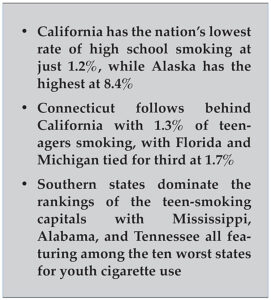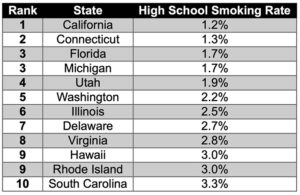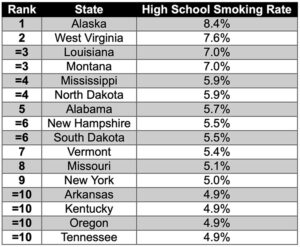New research has revealed the states with the least high school smokers, with California placing first.
The study by vape experts at Provape examined data from the American Lung Association to reveal which states had the most and least teenage cigarette users. The results showed huge differences across the country, with some states having seven times more teen smokers than others.
 California recorded the nation’s lowest high school smoking rate during the study, with just 1.2% of students using cigarettes. The state kept numbers nearly seven times lower than Alaska, showing the success of tobacco prevention programs and public health campaigns aimed at young people throughout schools and communities.
California recorded the nation’s lowest high school smoking rate during the study, with just 1.2% of students using cigarettes. The state kept numbers nearly seven times lower than Alaska, showing the success of tobacco prevention programs and public health campaigns aimed at young people throughout schools and communities.
Connecticut had the second-lowest smoking rate among high school students, with only 1.3% reporting cigarette use. Prevention worked particularly well in this New England state compared to nearby Vermont, which ranked much higher despite being geographically close.
Florida and Michigan tied for third-lowest position with identical 1.7% high school smoking rates. Teen smoking levels in these states reached less than one-third of those found in top-ranked states, suggesting their prevention approaches might work better than methods used in states with higher percentages.
Utah had the fourth-lowest rate with 1.9% of high school students smoking cigarettes. The state’s large Mormon population, which typically avoids tobacco, probably helped create this low percentage according to experts familiar with local practices discouraging smoking.
Washington had the fifth-lowest smoking rate nationally at 2.2% of high schoolers reporting cigarette use. This Pacific Northwest state showed much lower youth smoking rates than northern neighbor Alaska, which topped rankings despite sharing similar geography and climate challenges.
Illinois ranked sixth-lowest with 2.5% of high school students reporting cigarette use. Smoking rates in the Prairie State dropped to less than half those of neighboring Missouri, highlighting major policy or cultural differences between adjacent states resulting in vastly different youth tobacco outcomes.
Delaware had the seventh-lowest rate with 2.7% of high schoolers smoking. The First State maintained lower youth smoking rates than most neighbors despite its compact size and relatively crowded population centers where peer pressure might typically drive higher rates.
Virginia ranked eighth-lowest with 2.8% of high school students smoking cigarettes. Much lower youth smoking showed up here than in neighboring West Virginia despite historical tobacco farming ties, indicating successful prevention programs have overcome traditional smoking acceptance.
Hawaii and Rhode Island shared the ninth-lowest position with 3% of high schoolers reporting cigarette use. Despite being separated by thousands of miles, these states showed similar success limiting youth smoking through comprehensive prevention efforts and strong public health messaging.
Rounding out the list of states with the lowest high school smoking rates is South Carolina, with 3.3% of students reporting cigarette use.
Alaska reported the highest rate of cigarette use in high school students at 8.4%. Despite the state’s efforts to reduce tobacco use, such as the public education campaign ‘Not Buying It’ which is aimed at teens, Alaska’s rate of smokers in high school is the highest in the U.S.
West Virginia claimed second place for high school smokers during the study period, with 7.6% of students reporting cigarette use. Smoking rates in West Virginia ran nearly six times higher than California, which had the nation’s lowest rate despite having millions more teenagers.
Louisiana and Montana tied for third, with 7% of high school students in both states using cigarettes. These rates stayed well above normal despite years of anti-smoking campaigns targeting young people.
Mississippi and North Dakota shared the fourth position with smoking rates of 5.9% among high schoolers. Their percentages sit among the highest nationwide, revealing worrying patterns of youth tobacco use that continue despite numerous public health efforts and awareness programs.
Alabama took fifth place with 5.7% of high school students smoking cigarettes. Teenagers in this Southern state smoke at more than four times the rate of California teens, showing major differences between regions when looking at youth tobacco habits.
New Hampshire and South Dakota both recorded smoking rates of 5.5%, tying for sixth place. Similar patterns emerged despite these states being thousands of miles apart, suggesting teen smoking habits cross regional lines and likely come from other factors.
Vermont followed at seventh place with 5.4% of high schoolers smoking. The Green Mountain State stands out with much higher youth smoking than neighboring Massachusetts and Connecticut, which see rates of 3.5% and 1.3%, respectively.
Missouri landed eighth with 5.1% of high school students reporting cigarette use. Youth smoking in this Midwestern state more than doubled the rates in neighboring Illinois, showing dramatic differences even between states that share borders and many cultural connections.
New York secured the ninth spot with exactly 5% of high school students smoking cigarettes. The Empire State recorded surprisingly high youth smoking despite strict tobacco laws and high cigarette taxes.
Four states round out the top ten, including Arkansas, Kentucky, Oregon, and Tennessee, with identical high school smoking rates of 4.9%.
Joe Tucker, COO at Provape, commented on the findings:
“States with lower rates have typically invested more in youth prevention programs and implemented stronger tobacco control policies. The significant variation in high school smoking rates across states points to the impact of these different approaches to tobacco prevention and education.
“Some states face unique challenges due to cultural factors, socioeconomic issues, and historical connections to the tobacco industry. Many areas with higher youth smoking rates often lack adequate funding for prevention or have limited access to cessation resources.
“These numbers reflect only cigarette smoking and don’t account for the shift to vaping products among teenagers. Many young people who might have smoked cigarettes in previous generations are now using e-cigarettes instead, which may partially explain the lower cigarette smoking rates in certain states.”
•••
Methodology: Data from 2019 to 2023 was gathered from the American Lung Association on the percentage of high school smokers in each state. Smoking was defined as having smoked on at least one day during the 30 days before the survey.
Source: American Lung Association – https://www.lung.org/research/trends-in-lung-disease/tobacco-trends-brief/data-tables/youth-cigarette-smoking-tobacco-use-by-state
•••
Article provided by https://provape.com, which provides products that include nicotine in its ingredients.




